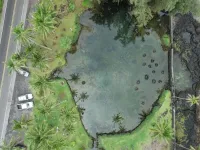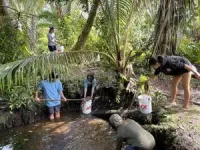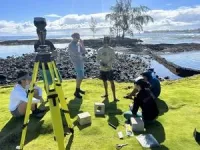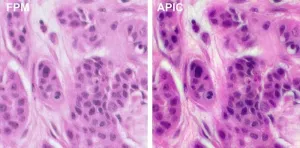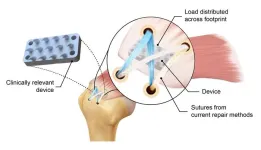(Press-News.org) Scientists and kiaʻi loko (fishpond practitioners) have a new tool to aid their efforts to restore and ensure the resilience of Native Hawaiian fishponds. Researchers from the University of Hawai‘i (UH) and fishpond stewards in Hilo, Hawai‘i recently published a study in the Journal of Remote Sensing highlighting the use of uncrewed aerial vehicles (UAVs) to support integrated coastal zone management, including at cultural heritage sites.
“We discovered that drones are effective and cost-efficient tools for mapping loko iʻa at the community level, providing kiaʻi loko iʻa with better insights into the timing and locations of flooding and future sea level rise impacts on their fishponds,” said Kainalu Steward, lead author of the study and Earth sciences doctoral student in the UH Mānoa School of Ocean and Earth Science and Technology (SOEST).
Loko iʻa, traditional Hawaiian fishponds located along the coastline, have historically provided sustainable seafood sources. These culturally important sites are undergoing revitalization through community-driven restoration efforts. However, as sea level rise poses a significant climate-induced threat to coastal areas, loko iʻa managers are seeking adaptive strategies to address related concerns such as flooding, water quality, and the viability of native fish species.
King Tides as estimate of future sea level
The researchers’ surveys determined that by 2060, the average sea level along the Keaukaha coastline in Hilo will be similar to the extreme tidal events, known as King Tides, during summer 2023. Steward and Brianna Ninomoto, a master’s student in tropical conservation biology and environmental science at UH Hilo, devised a plan to investigate how future sea level rise will affect loko iʻa by assessing the impacts of the summer 2023 King Tides.
Throughout the summer, including during the extreme high tide events, researchers collected drone imagery in real time and monitored water levels using sensors submerged at each loko iʻa. With this, they compared flooding predicted from drone-derived topography models and more commonly used Light Detection and Ranging (LiDAR)-derived models to the observed flooding documented by drone imagery.
The team found that digital elevation models derived from drone surveys accurately estimated observed flooding during extreme high tide events, whereas LiDAR flood models, which are nearly 20 years old for the Hilo region, significantly overestimated observed flooding by two to five times. Loko iʻa practitioners, however, reported that occasionally during severe weather and large swell events, these particular areas modeled from LiDAR data do flood. This suggests that data collected by LiDAR offers a more conservative and cautious understanding of coastal flooding, emphasizing that UAV-derived and LiDAR-based data are important components of the suite of coastal management tools.
Supporting Native Hawaiian scientists, community
Funding for this research was awarded through NASA’s Minority University Research and Education Project (MUREP) for a project, “Quantifying Vulnerability to Sea Level Rise Across Multiple Coastal Typologies,” led by co-author and SOEST assistant professor of Earth sciences, Haunani Kane. The program engages underrepresented populations through a wide variety of initiatives. Multiyear grants are awarded to assist Minority Institution faculty and students in research related to pertinent missions.
“One of the goals of this project is to increase the capacity of Native Hawaiian students in assessing and evaluating impacts of sea level rise upon cultural resource sites,” said Kane. “This project supports five undergraduate students and three local Native Hawaiian students as they work towards obtaining their Master’s and Doctorate degrees in science at the University of Hawaiʻi.”
“This research is important for enhancing coastal community adaptation, resilience, and food security in the face of climate change,” said Ninomoto. “This work was ultimately done to support loko iʻa practitioners along Keaukaha and the future management of their ʻāina as the impacts of flooding become more severe.”
Another component of the NASA-funded project is storytelling and outreach to the community. John Burns, study co-author and UH Hilo associate professor in marine science and data science, and the MEGA Lab have a community lab space at Mokupāpapa Discovery Center in Downtown Hilo where the research team uses virtual reality and short films to share stories and engage the community in discussions of how climate change is impacting coastal resources in Hawaiʻi.
UH researchers plan to continue working with the kiaʻi loko iʻa in Keaukaha, to provide up-to-date aerial imagery of their fishpond to support restoration efforts.
“Loko iʻa are examples of how our kūpuna have adapted to changes in climate for generations, and we want to contribute towards their resilience and perpetuation by integrating modern technology,” said Steward.
END
Drone technology aid restoration, resilience of Native Hawaiian fishponds
2024-06-28
ELSE PRESS RELEASES FROM THIS DATE:
New computational microscopy technique provides more direct route to crisp images
2024-06-28
For hundreds of years, the clarity and magnification of microscopes were ultimately limited by the physical properties of their optical lenses. Microscope makers pushed those boundaries by making increasingly complicated and expensive stacks of lens elements. Still, scientists had to decide between high resolution and a small field of view on the one hand or low resolution and a large field of view on the other.
In 2013, a team of Caltech engineers introduced a microscopy technique called FPM (for ...
11th-grade student wins competition with research conducted at UTA
2024-06-28
A Plano high school student conducting research in a University of Texas at Arlington chemistry professor’s lab earned multiple awards at the annual Regeneron International Science and Engineering Fair (ISEF). Regeneron ISEF is the world’s largest pre-college STEM competition for students in grades 9-12.
Chloe Lee, a junior in the International Baccalaureate program at Plano East Senior High School, conducted research in the lab of Junha Jeon, associate professor of chemistry and ...
Deep learning-assisted lesion segmentation in PET/CT imaging: A feasibility study for salvage radiation therapy in prostate cancer
2024-06-28
“The deployment of DL segmentation methods in 18F-fluciclovine PET/CT imaging represents an intriguing research direction for precision medicine in salvage prostate cancer care.”
BUFFALO, NY- June 28, 2024 – A new editorial paper was published in Oncoscience (Volume 11) on May 20, 2024, entitled, “Deep learning-assisted lesion segmentation in PET/CT imaging: A feasibility study for salvage radiation therapy in prostate cancer.”
In this new editorial, researchers Richard L.J. Qiu, Chih-Wei Chang, ...
Dementia cost calculator will provide precise, annual, national estimates of Alzheimer's financial toll
2024-06-28
An A-list of researchers from across USC is building a dementia cost model that will generate comprehensive national, annual estimates of the cost of dementia that could benefit patients and their families, thanks to a five-year, $8.2 million federal grant from the National Institute on Aging.
A firm grip on the costs of the disease could assist families living with dementia with planning their budgets and support needs, inform treatment and caregiving options, and help shape health care policy.
“We currently have estimates for a particular ...
Moffitt researchers develop synthesis method to enhance access to cancer-fighting withanolides
2024-06-28
TAMPA, Fla. — Withanolides, a class of naturally occurring compounds found in plants, have long been a focus of cancer research due to their ability to inhibit cancer cell growth, induce cell death and prevent metastasis. These compounds are important in developing new cancer treatments. However, the difficulty of obtaining enough of these compounds from plants has hindered research and therapeutic development.
Moffitt Cancer Center researchers have developed a groundbreaking method for the scalable synthesis of withanolides. This innovative approach, published in Science Advances, could revolutionize cancer research by providing ...
Analysis of NASA InSight data suggests Mars hit by meteoroids more often than thought
2024-06-28
PROVIDENCE, R.I. [Brown University] — NASA’s Mars InSight Lander may be resting on the Red Planet in retirement, but data from the robotic explorer is still leading to seismic discoveries on Earth.
In one of the latest studies using data from the spacecraft, an international team of scientists led by a Brown University researcher found that Mars may be getting bombarded by space rocks at more frequent rates than previously thought. Impact rates could be two to 10 times higher than previously estimated, depending on the size of the meteoroids, according to the study published in Science Advances.
“It’s ...
Serotonin 2C receptor regulates memory in mice and humans – implications for Alzheimer’s disease
2024-06-28
Researchers at Baylor College of Medicine, the University of Cambridge in the U.K. and collaborating institutions have shown that serotonin 2C receptor in the brain regulates memory in people and animal models. The findings, published in the journal Science Advances, not only provide new insights into the factors involved in healthy memory but also in conditions associated with memory loss, like Alzheimer’s disease, and suggest novel avenues for treatment.
“Serotonin, a compound produced by neurons in the midbrain, acts as a neurotransmitter, passing messages between brain cells,” said co-corresponding author Dr. Yong Xu, professor of pediatrics ...
New device inspired by python teeth doubles strength of rotator cuff repairs
2024-06-28
New York, NY—June 24, 2024—Most people, when they think about pythons, visualize the huge snake constricting and swallowing victims whole. But did you know that pythons initially hold onto their prey with their sharp, backward-curving teeth? Medical researchers have long been aware that these teeth are perfect for grasping soft tissue rather than cutting through it, but no one has yet been able to put this concept into surgical practice. Over the years, mimicking these teeth for use in surgery has been a frequent topic ...
The beginnings of fashion
2024-06-28
EMBARGO: 4:00 Sydney AEST June 29 | 14:00 US ET June 28 2024
The beginnings of fashion
Paleolithic eyed needles and the evolution of dress
A team of researchers led by an archaeologist at the University of Sydney are the first to suggest that eyed needles were a new technological innovation used to adorn clothing for social and cultural purposes, marking the major shift from clothes as protection to clothes as an expression of identity.
“Eyed needle tools are an important development in prehistory because they document a transition in the function of clothing from utilitarian to social purposes,” says Dr Ian Gilligan, Honorary Associate ...
Why some tumors are resistant to cell therapies
2024-06-28
FRANKFURT. In congratulating the CARISMa scientists, Goethe University President Prof. Enrico Schleiff said: “The new LOEWE network sets up in Hesse an innovative research program that is currently gathering steam all over the world. It also expands Goethe University’s existing research profile and broadens our network of cooperation partners in the field of CAR cell therapy [editor’s note: CAR is the abbreviation for chimeric antigen receptor]. The network deliberately builds on our university’s ...
